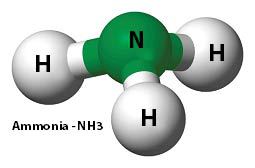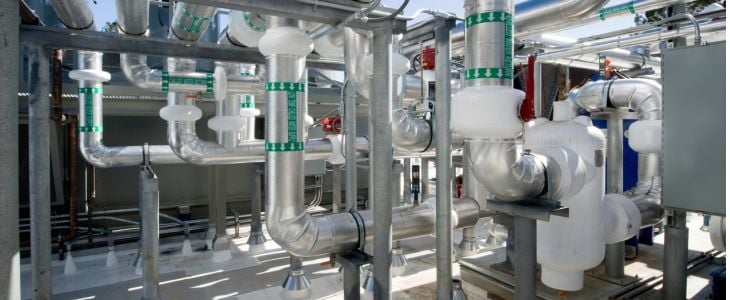If you’re wondering ‘What is ammonia refrigeration?’ you’ve probably heard recently of the increasing use of ammonia as an alternative to other refrigerants.
The growing interest in ammonia as a refrigerant is arising as refrigerant legislation imposes restrictions on other common alternatives, such as refrigerants based on chlorine and fluorine components. The potential of ammonia as a greener alternative (thanks to not contributing to global warming) is now being explored by a growing number of companies. This is particularly true in the devising of sustainable district cooling projects.
Keep reading to find out what ammonia refrigeration is, what type of ammonia is used in refrigeration and its benefits.
| Table of contents |
| What is ammonia refrigeration? The basics |
| What type of ammonia is used in refrigeration? |
| The applications of ammonia refrigeration |
| Ammonia refrigeration at Araner |
What is ammonia refrigeration? The basics
Ammonia refrigeration is a type of refrigeration system that uses ammonia (Ammonia (a compound of nitrogen and hydrogen - NH3) as a refrigerant.
A widely used and well-established method for industrial refrigeration applications, it’s now being hailed as a more sustainable alternative for cooling and one that aligns with current restrictions in the matter. But in fact, ammonia was one of the earliest refrigerants, only being replaced by chlorofluorocarbons (CFCs) in the 1920s.
The working principle of an ammonia refrigeration system is as follows: ammonia gas is compressed, a process that increases its pressure and temperature. Removing heat from this gas means it reaches condensation and thus turns into a liquid state. The now condensed liquid ammonia flows through an expansion valve, where its pressure is reduced. The result is its evaporation, a process that also enables the substance to absorb heat from the surroundings, thereby cooling the area.
Some of the advantages of ammonia refrigeration include:
- Excellent thermodynamic properties, allowing it to absorb large amounts of heat during evaporation
- Outstanding efficiencies. At full capacity, ammonia refrigeration systems can be up to 20% more efficient than other industrial refrigeration systems at full capacity, while also showing great results at part capacity.
- Wide operating range, making it suitable for various cooling requirements.
- An environmentally-friendly choice thanks to presenting zero ozone depletion potential (ODP) and a low global warming potential (GWP)
- Low cost (which may reach even one-tenth of conventional hydrofluorocarbon refrigerants) and low operational costs
What type of ammonia is used in refrigeration?
Ammonia (NH3 , United Nations Chemical I.D. #1005) is produced both naturally and as a result of man-made reactive processes, such as gas coming from livestock animals, fuel combustion and sewage treatment plants.
An alkaline, colorless chemical compound, ammonia was first used as a refrigerant in the 19th century.

When it comes to the type of ammonia used in refrigeration, it’s important to understand that this substance’s level of purity translates into four grades: fertilizer, refrigerant, federal and metallurgical).
In the case of the type of ammonia used in refrigeration, it must be 99.98 percent pure, so that it is relatively free of water and other common impurities found in other ammonia grades. It’s a clear and colorless gas or liquid, its purity being crucial to fulfill its mission as a refrigerant. In fact, it should contain a maximum of 150 ppm water, 3 ppm oil and 0.2 ml/g non-condensables.
Only around 2% of the estimated 100 million metric tons of ammonia produced on a global scale is employed as a refrigerant. Other more common issues include agricultural purposes (as a fertilizer or antifungal) and industrial applications.
The applications of ammonia refrigeration
Large-scale refrigerators systems using absorption chillers have been typically employing ammonia as a refrigerant. These may include food and beverage manufacturing facilities, cold storage warehouses, combined cycle power plants, and petrochemical facilities. On the other hand, ammonia refrigerant can be used also in compression chillers.
This has been largely thanks to larger facilities presenting a larger room for dispersion as well as limited exposure to the potential safety implications that must be considered when employing ammonia.

Some of the common industrial and commercial uses of ammonia as a refrigerant include:
- Food processing plants for products such as meat packing, dairy, fish and fruit and vegetables. In this context, ammonia helps provide cooling for cold storage, freezing, and chilling applications that preserve and extend the shelf life of perishable food products.
- Cold storage warehouses, which apart from food, include pharmaceuticals, chemicals and other temperature-sensitive products, preventing their spoilage or degradation.
- Breweries and the beverage industry, helping cool and maintain desired temperatures during processes such as brewing, fermentation, and storage.
- Chemical industry: various processes, reactors, and equipment require ammonia refrigeration for the production, refining, and storage of chemicals.
- Petrochemical industry: as part of operations such as natural gas processing and the cooling of equipment and storage tanks.
Ammonia refrigeration at Araner
At ARANER, we help companies devise the best option for their cooling needs. Considering the benefits of ammonia refrigeration outlined above, we often consider ammonia refrigeration.
Greater environmental advantages and energy efficiencies, as well as minimizing uncertainties considering changing regulations regarding other refrigerant options, are common reasons to pick ammonia as the refrigerant choice.
Additionally, we help companies design and implement an ammonia refrigeration structure that takes into account this substance’s safety requirements, as well as the structure’s overall cost-efficiency.
With decades-long expertise in energy and cooling engineering, we’re now paving the way for cutting-edge district cooling solutions as well as industrial refrigeration. Get in touch with us and discover how we can help you achieve safety and efficiency in your refrigeration project.










